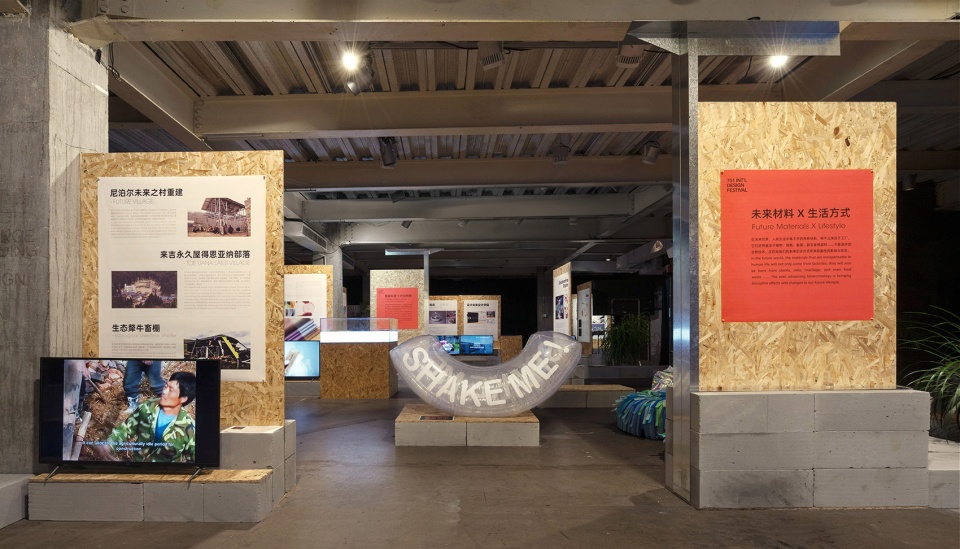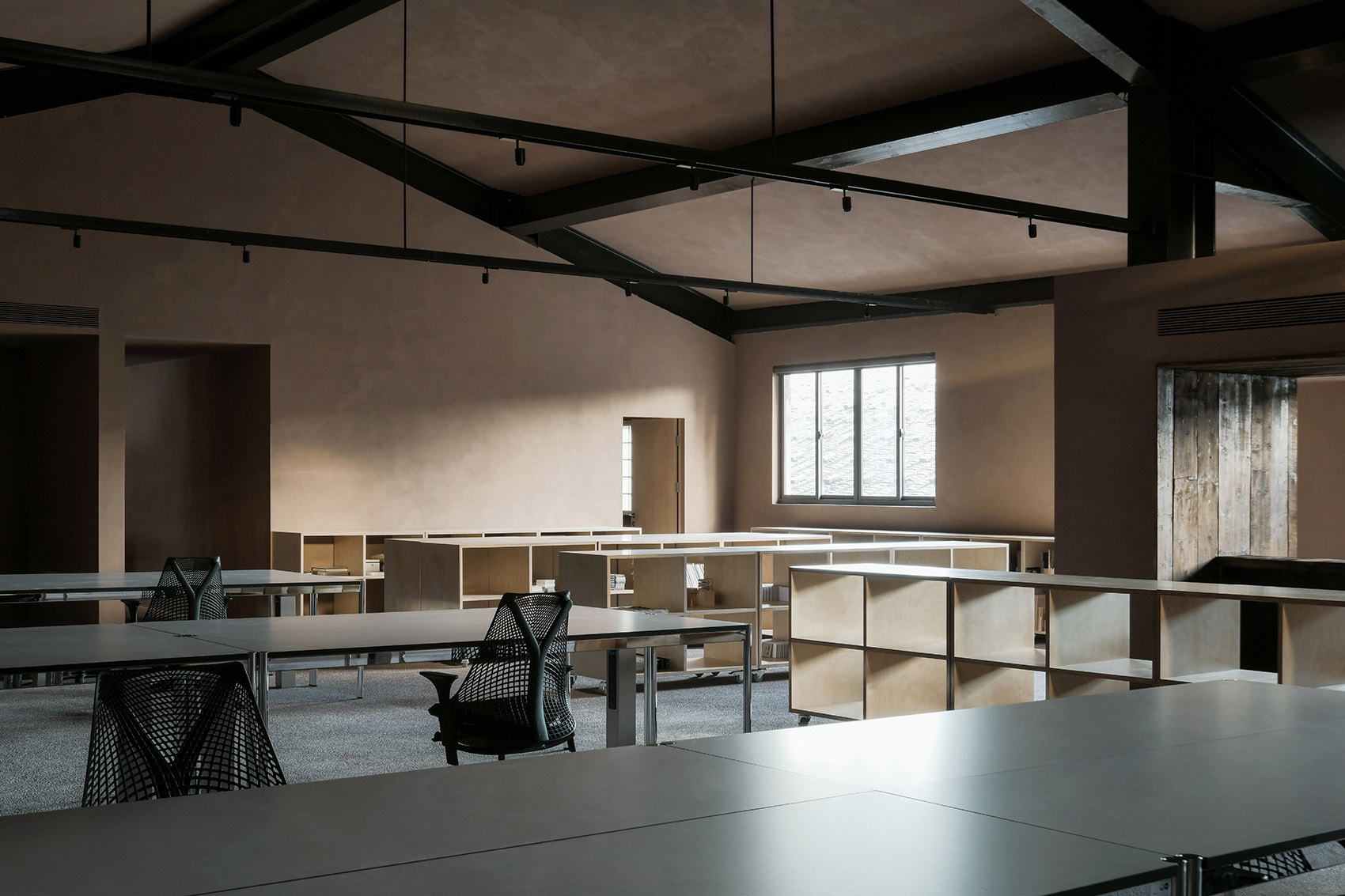

项目坐落于法国纳博讷市Robine运河附近,是一座全新的罗马文物博物馆。项目由著名建筑事务所Foster + Partners设计建造,在经过奥克西坦大区区长卡罗尔·戴乐卡(Carole DELGA)女士主持的开馆仪式后,Narbo Via正式向公众开放,并成为城市入口处的全新地标。
Narbo Via – a new museum of Roman antiquities in Narbonne – has officially opened following an inauguration ceremony attended by the conseil de la Region Carole Delga. The building, designed and engineered by Foster + Partners is set to become a new landmark at the entrance to the city, on a site adjacent to the Canal de la Robine.
巨大的屋顶平面为建筑赋予了一种冷静克制的氛围感,使博物馆成为城市入口处的建筑纪念碑。建筑内部包含了用于永久性和临时性展览的画廊、多媒体教育中心、礼堂、餐厅和书店,以及用于研究、修复、储藏的专业空间;建筑外部还设有花园与露天剧场,为户外表演及活动提供了充足的场地。
Raised on top of a podium, the museum provides a sense of restrained civic and architectural monumentality at the entrance to the city. The building incorporates galleries for permanent and temporary exhibitions, a multimedia education centre, auditorium, restaurant and bookshop, as well as research, restoration and storage facilities. Externally there are formal gardens and an amphitheatre for outdoor performances.
▼巨大的平屋顶使博物馆成为城市入口处的建筑纪念碑,the museum provides an architectural monumentality at the entrance to the city ©Nigel Young / Foster + Partners
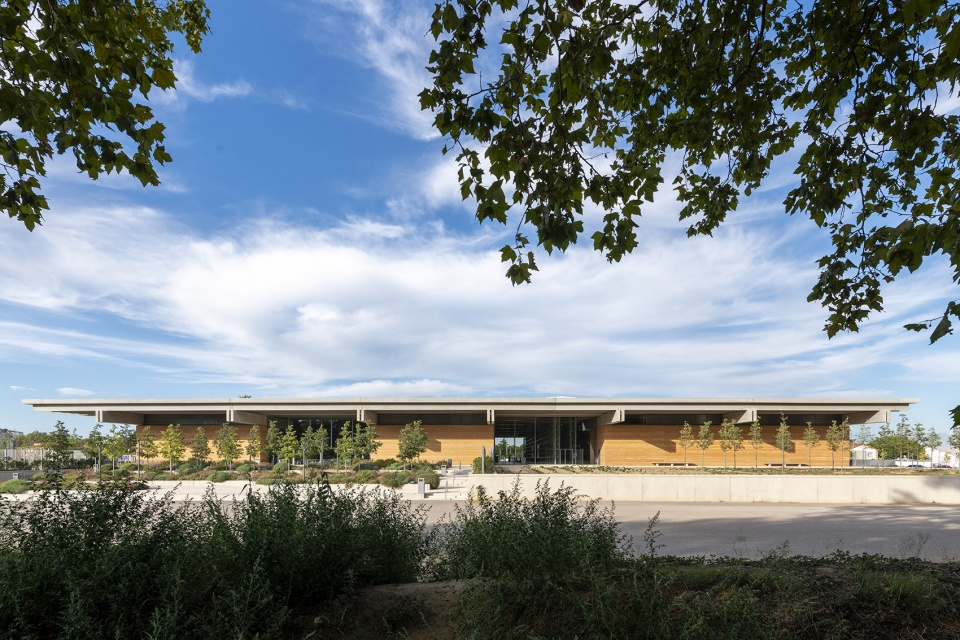
在项目中,景观的设计增强了博物馆与运河的联系,在场地中营造出宁静的自然环境。受到经典法式花园和罗马庭院的启发,设计师在场地中设置了一处引人注目的圆形露天剧场,为博物馆提供了用于户外展览与活动的场所。设计旨在为项目打造一个受欢迎的、景观化入口,并通过一条全新的坡道将博物馆与Robine运河的河边纤道连接在一起。坡道落成后将大大缩减博物馆与市中心之间的步行路程,并为人们创造出一段风景优美、宁静宜人的观光路线。
The landscaping reinforces the connection with the canal to create a tranquil natural setting. Inspired by formal French gardens and the Roman courtyard, the museum’s grounds feature an amphitheatre for open- air displays and events. The design anticipates a welcoming, landscaped entrance via a new ramp that links the museum to the existing towpath along the Canal de la Robine. This will create a serene pedestrian connection to the city centre, which will now be only a short walk from the museum.
▼全新的坡道将博物馆与Robine运河的河边纤道连接在一起,the new ramp that links the museum to the existing towpath along the Canal de la Robine ©Philippe Chancel
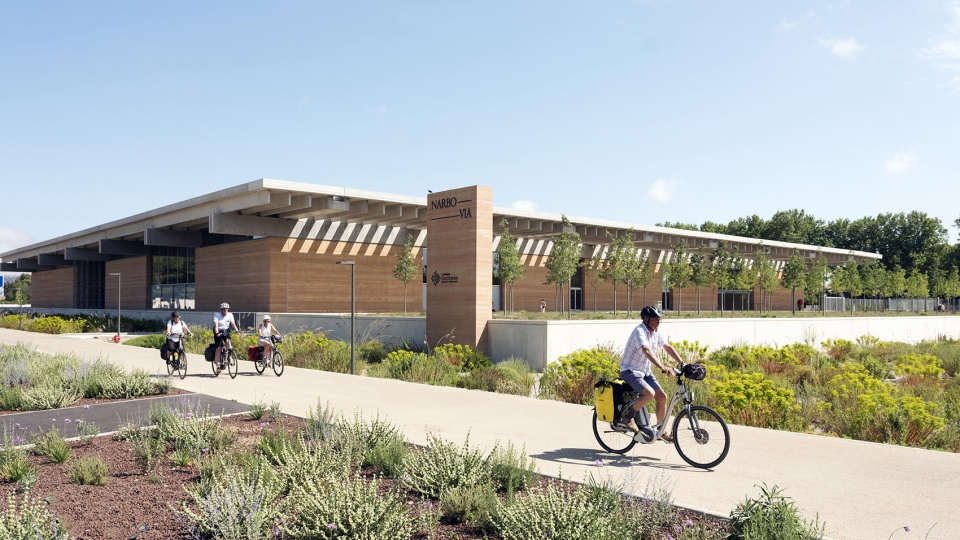
▼室外花园在场地中营造出宁静的自然环境,The outdoor garden creates a peaceful natural environment in the site ©Nigel Young / Foster + Partners & Philippe Chancel
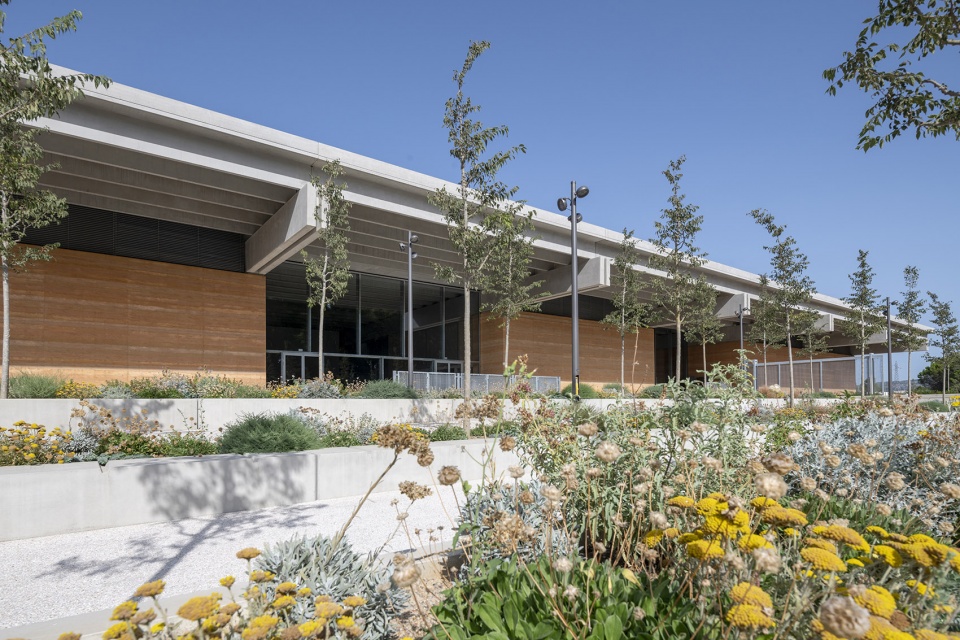
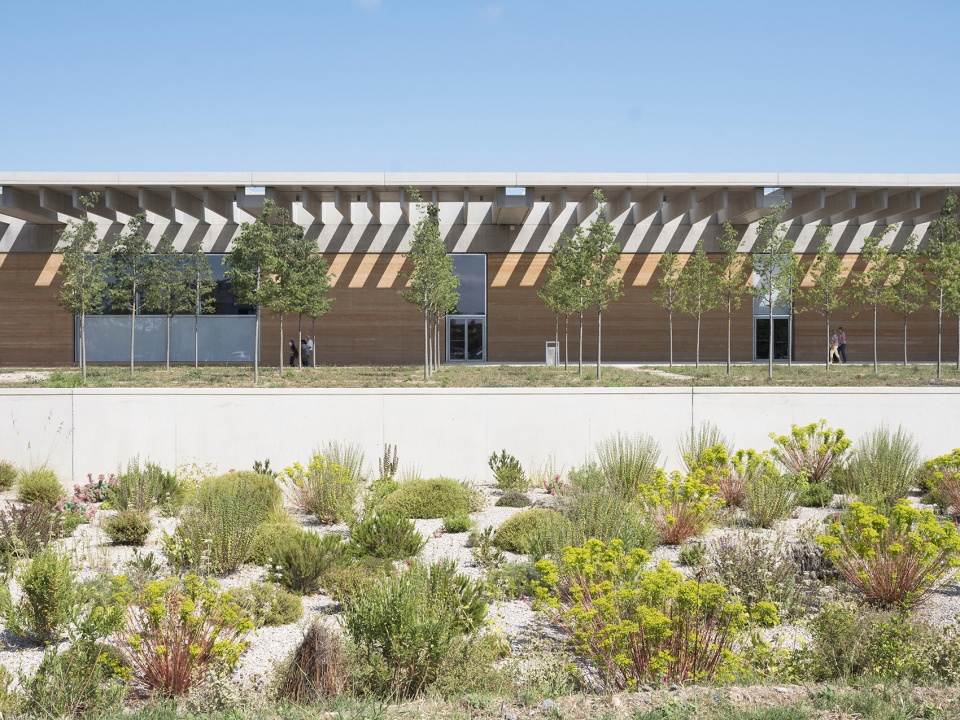
暴露的混凝土横梁将屋顶悬于墙体结构之上,一系列高窗与采光天窗为室内营造出通透明亮的空间氛围,此外,设计师还将屋顶结构还向建筑外部延伸,在博物馆周围的人行道上方形成了遮阳顶棚。可持续环境策略是设计中重要的组成部分,受到古罗马建造技术的启发,建筑中的大部分服务设施都设置在地下空间中。此外,在室内较低的位置,冷空气以低速从空调系统中推出,这种通风与保温策略减少了需要调节的空气体积,在提高能源的效率的同时,保证了稳定且舒适的室内体感环境。高高的天花板形成了巨大的空间体量,创造出热飞轮效应,自然地推动热空气向上流动,最终从建筑上部排除。
The canopy is elevated above a clerestory, punctuated with light wells, and it extends to provide a canopy over the walkways around the museum. As part of its sustainable environmental agenda, inspired by Roman technology, the majority of the services in the building are contained within a subterranean void. The cool air is pushed out at a low level and at low velocity, allowing a smaller volume of air to be conditioned, while maintaining a comfortable environment. The large spatial volumes formed by the high ceilings create a thermal flywheel effect that naturally pushes warm air upwards, from where it is exhausted.
▼博物馆入口,entrance of the museum ©Nigel Young / Foster + Partners & Philippe Chancel
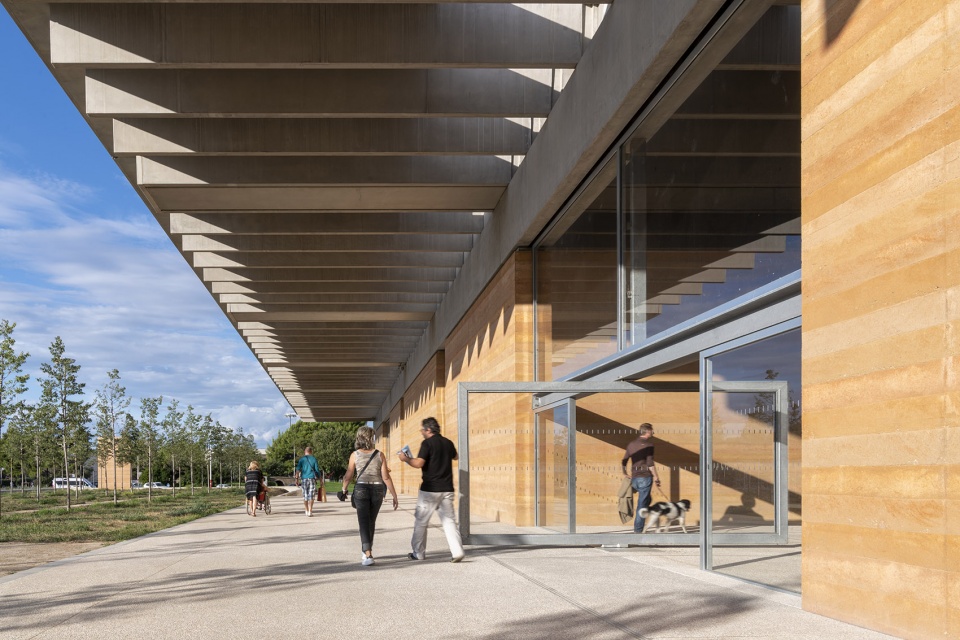
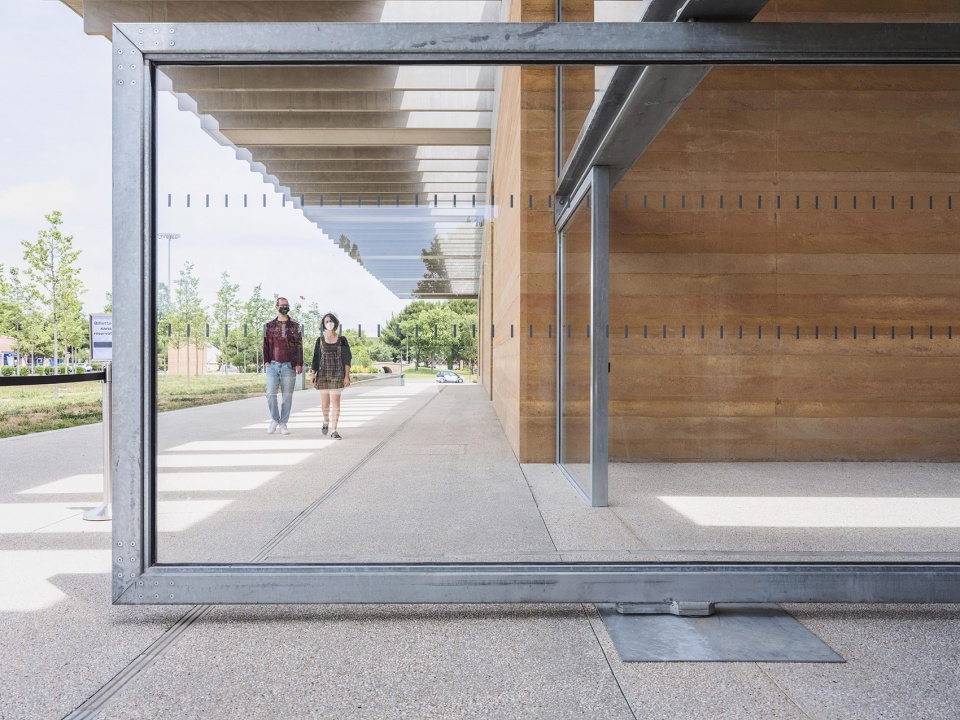
▼悬挑出来的屋顶结构形成了步道上方遮阳顶棚,The cantilevered roof structure forms a sunshade canopy over the walkway ©Nigel Young / Foster + Partners
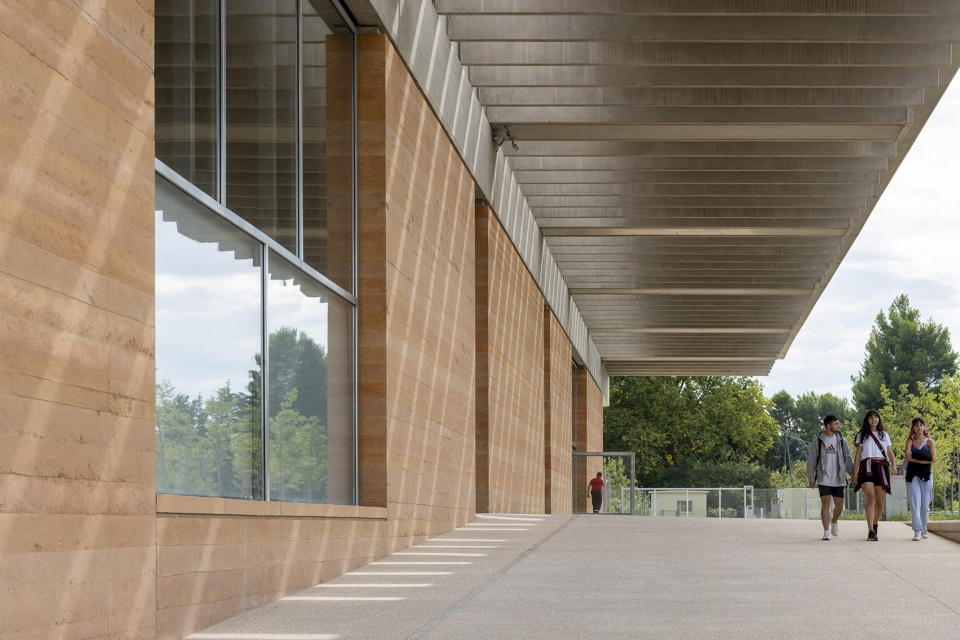
▼结构细部,details of the structure ©Nigel Young / Foster + Partners
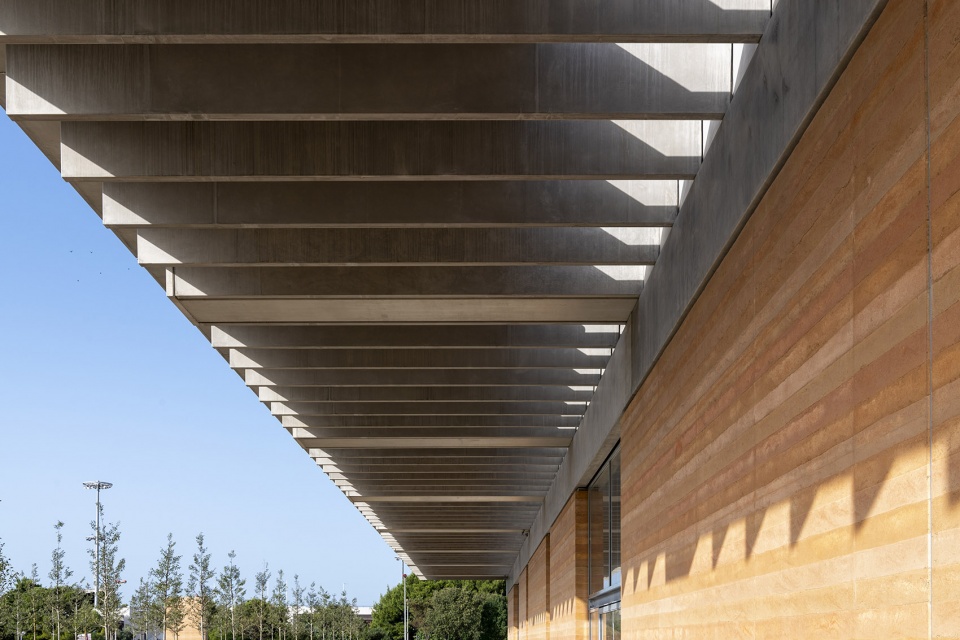
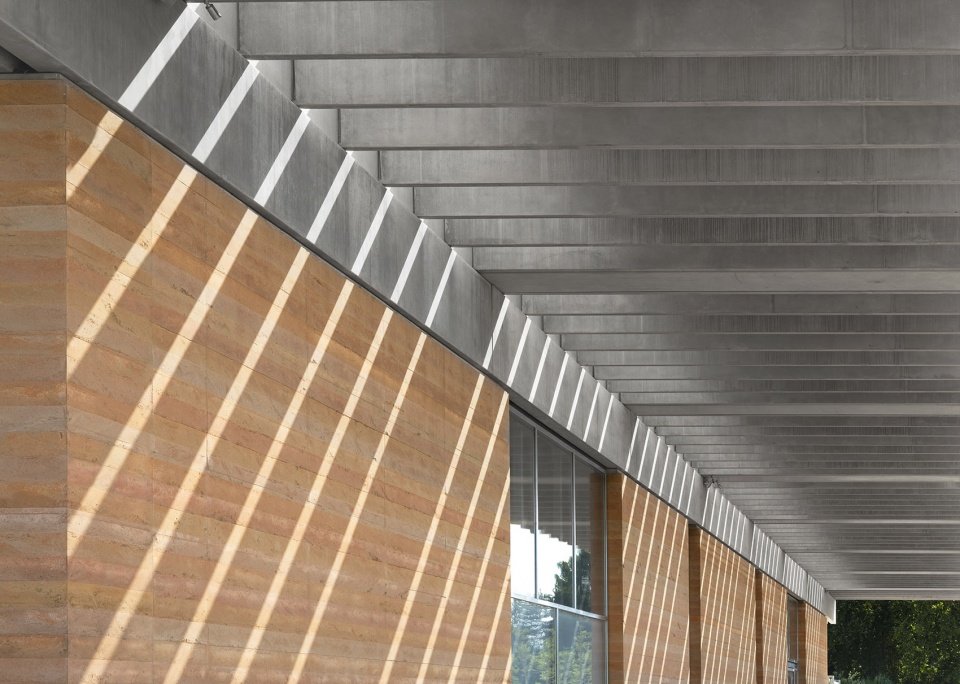
建筑的选材秉承了朴素的设计理念,并延续到彩色混凝土墙的建筑表达中。现场浇筑、并夯实的彩色干拌混凝土墙形成了分层的肌理,不仅彰显出博物馆的考古性质,同时让人联想到古罗马混凝土建筑。建筑结构的选型同样秉承了简单实用的设计理念。实体墙壁坚固耐用,且具有良好的隔热与承重功能。敦实的墙体支撑着上部的钢筋混凝土梁网格系统,钢筋混凝土双T型梁跨越在整个结构体系之上并支撑着最上方的屋面。建筑四周的大面积玻璃开窗则由螺栓直接固定在混凝土墙上。
The architecture is informed by an honest approach to materials which extends to the expression of the coloured concrete walls. Layers of dry-mixed concrete were tamped into place on-site, the resultant stratification calls to mind not only the archaeological nature of the museum, but also the inherent appearance of Roman concrete. The structural response also follows a similar approach that is underpinned by simplicity. The walls are solid, thermally insulated and load bearing. They support the roof with reinforced concrete double-T-beams that span onto a grid of reinforced concrete beams. The glazing around the enclosure simply bolts directly into the concrete walls.
▼入口大厅,entrance hall ©Nigel Young / Foster + Partners
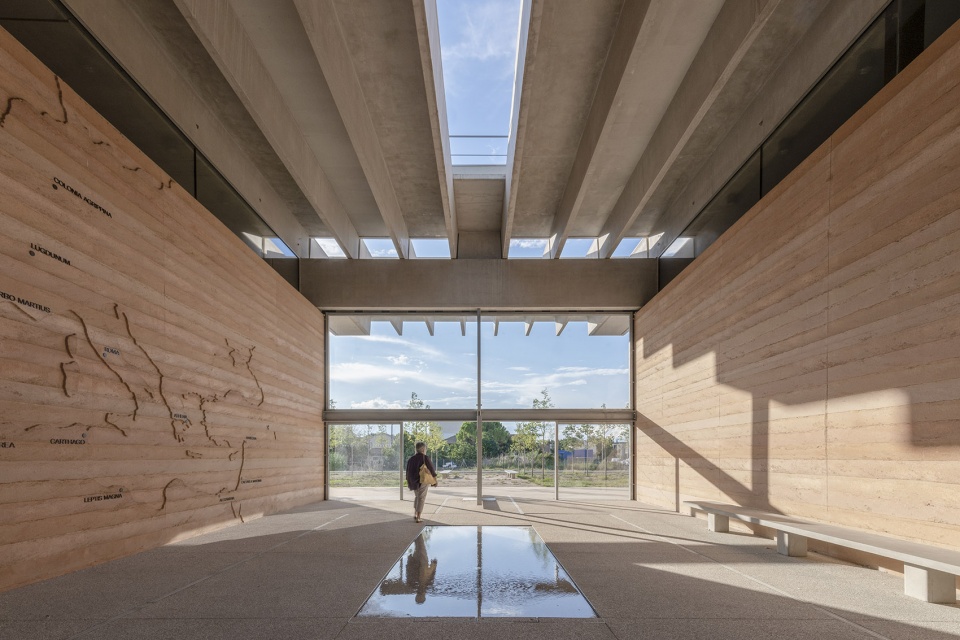
▼彩色混凝土墙面上分层的肌理彰显出博物馆的考古性质,Layers of dry-mixed concrete calls to mind the archaeological nature of the museum ©Nigel Young / Foster + Partners
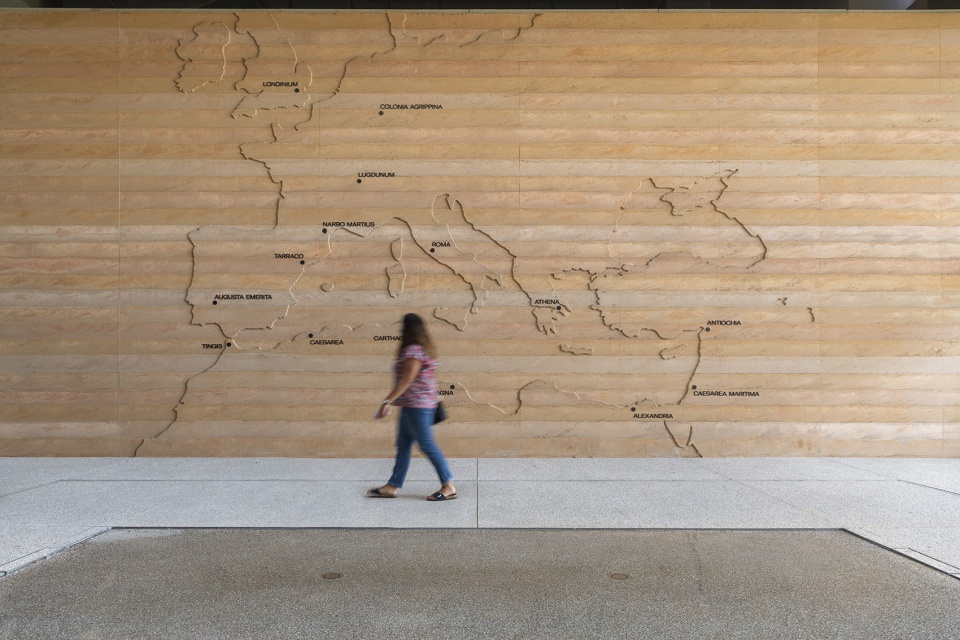
博物馆的核心区是一面“宝石墙”,这面“墙”在平面的中心位置形成了自然的边界,将公共画廊与专业修复空间分开。明媚的光线穿过文物石块之间的缝隙照射到室内空间中,参观者们还可以从缝隙空间中瞥见到考古学家和研究人员的工作场景。灵活的展览框架为替换藏品提供了便捷的条件,将“宝石墙”变身为学习的工具,以积极的方式激发着人们的求知欲与好奇心。巨大的混凝土屋顶具有良好的热学性能,并将博物馆内的所有空间统一起来,有助于实现全面的环境策略。
The centrepiece of the museum is a ‘Lapidary Wall’, which forms a natural boundary at the heart of the museum, separating the public galleries from the more private restoration spaces. Visitors can glimpse the work of the archaeologists and researchers through its mosaic of stone and light. The flexible display framework allows the reliefs to be easily reconfigured and used as an active tool for learning.
The museum spaces are unified beneath a concrete roof canopy, which provides thermal mass and contributes to a comprehensive environmental strategy.
▼博物馆中心位置的“宝石墙”,The centrepiece of the museum is a ‘Lapidary Wall’ ©Nigel Young / Foster + Partners
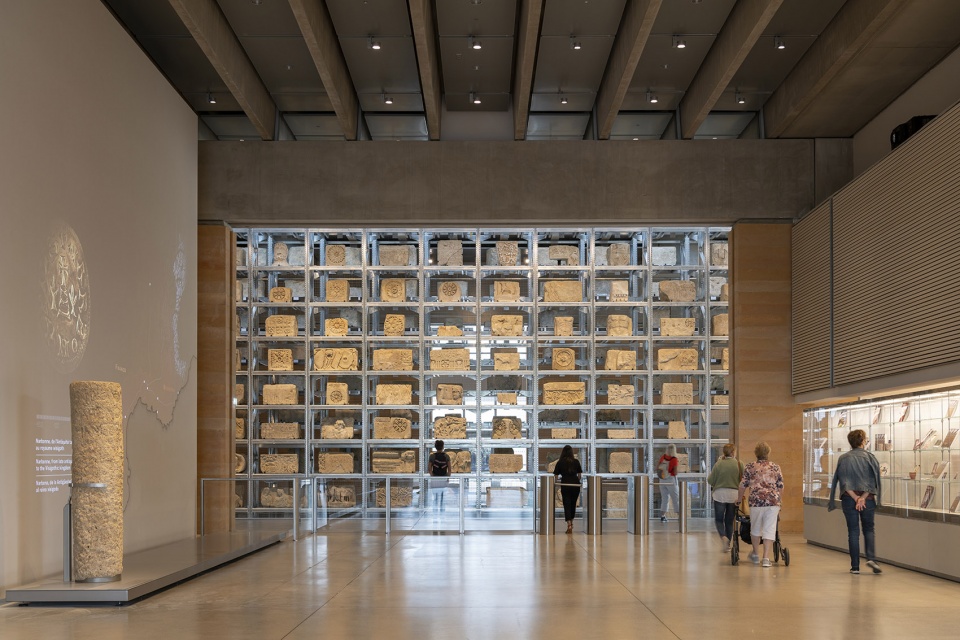

▼展示墙形成了公共区与研究区的自然边界,The display wall forms the natural boundary between the public area and the study area ©Nigel Young / Foster + Partners

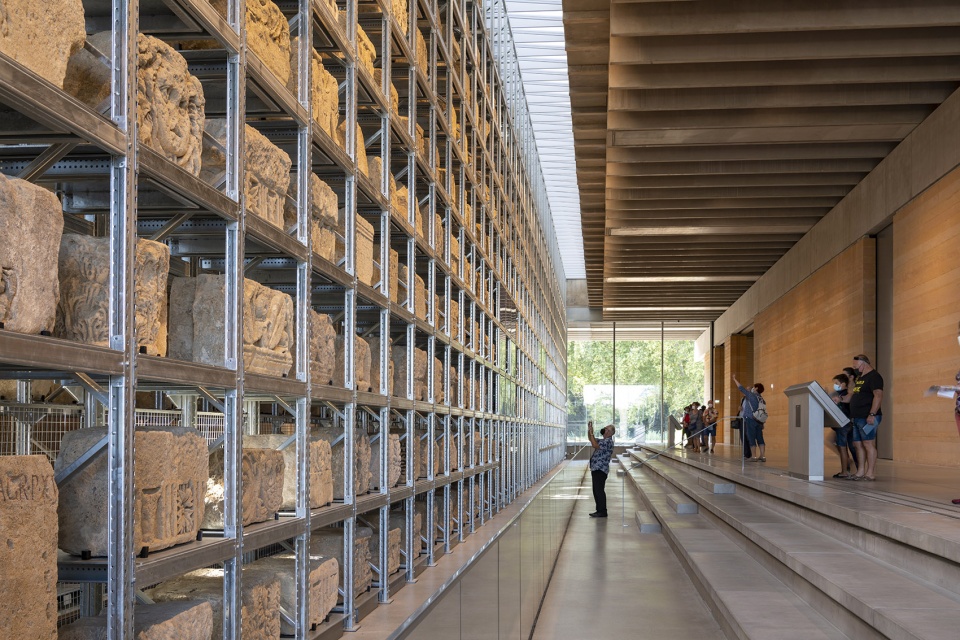
▼展示墙上的展品成为空间的主角,激发了人们探索求知的好奇心,The exhibits on the display wall become the protagonist of the space and stimulate people’s curiosity to explore and learn ©Nigel Young / Foster + Partners & Philippe Chancel
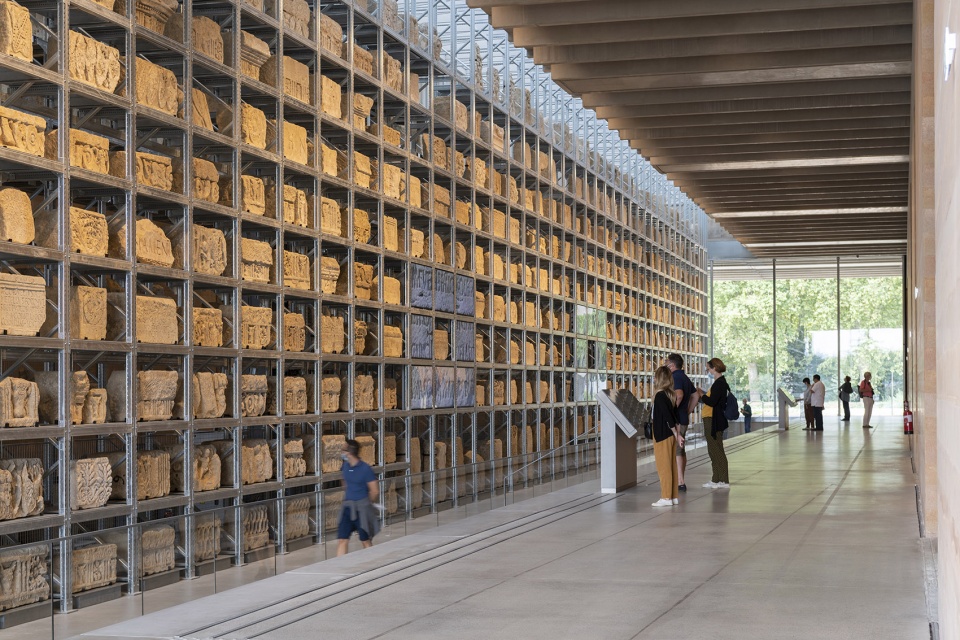
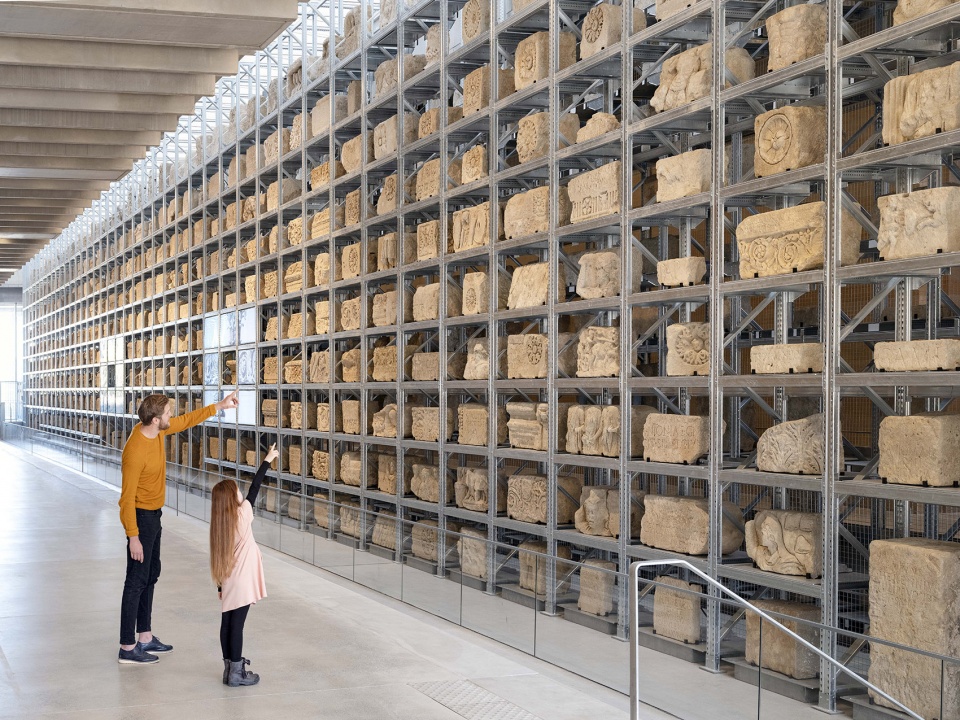
▼巨大的空间体量与展品带来强烈的视觉冲击力,The huge space volume and exhibits bring strong visual impact ©Philippe Chancel

▼展示墙结构细部,structure details of the ‘Lapidary Wall’ ©Nigel Young / Foster + Partners & Philippe Chancel
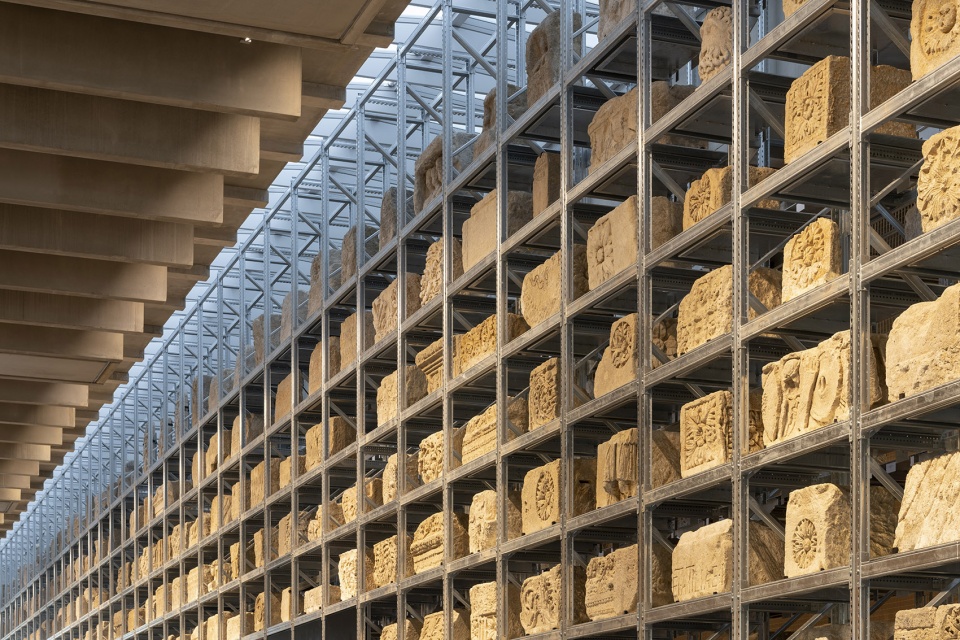
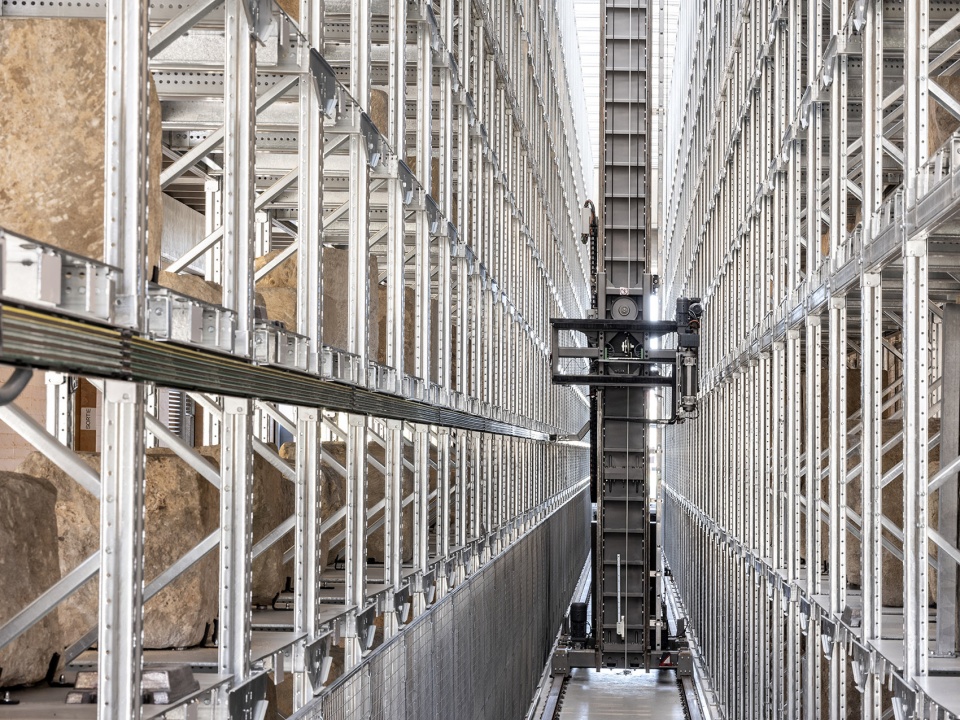
Foster + Partners的创始人兼执行主席Norman Foster说:“本项目延续了Foster工作室与法国南部市镇的长期合作关系。艺术对城市生活至关重要,而优秀的文化建筑则有潜力重塑和再生城市的‘场所感’,打破物质和社会阶级的屏障。Narbo Via的设计将新旧元素结合在一起,更新了人们对博物馆的认知,它不仅为当代人提供了一个反思历史的场所,同时也为下一代人创造了学习探索的机会。”
Norman Foster, Founder and Executive Chairman, Foster + Partners, said: “Our work on Narbo Via extends a long relationship between the Foster studio and the south of France. The arts are vital to the life of a city and a cultural building has the potential to reinvent and regenerate its ‘sense of place’, to break down physical and social barriers. Bringing together the old and the new, Narbo Via will renew the image of the museum, becoming not just a place for reflection but a creator of knowledge for future generations.”
▼“宝石墙”成为其他展区的空间背景,the display wall becomes the space background of other exhibition areas ©Nigel Young / Foster + Partners & Philippe Chancel
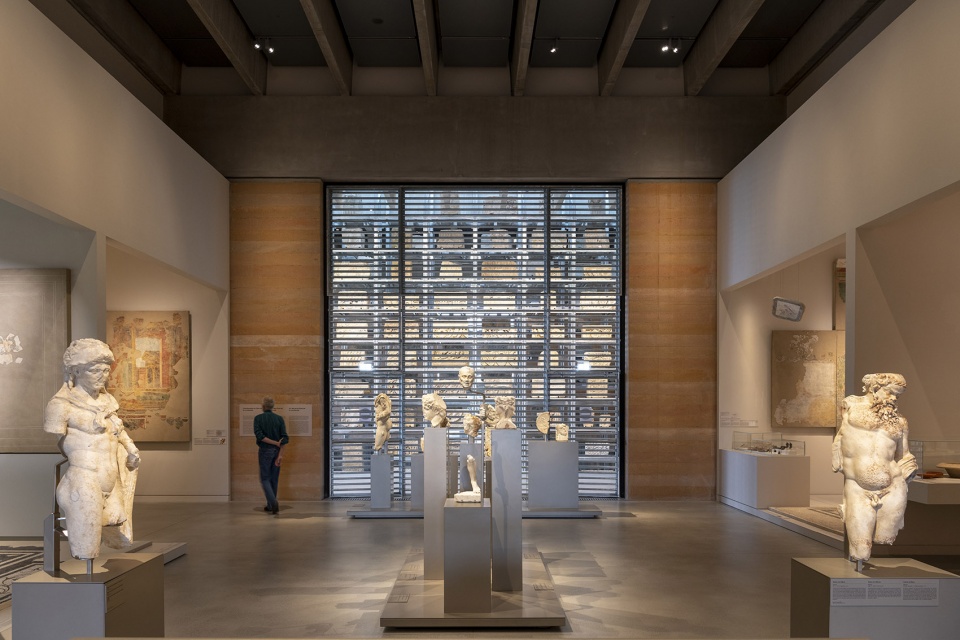
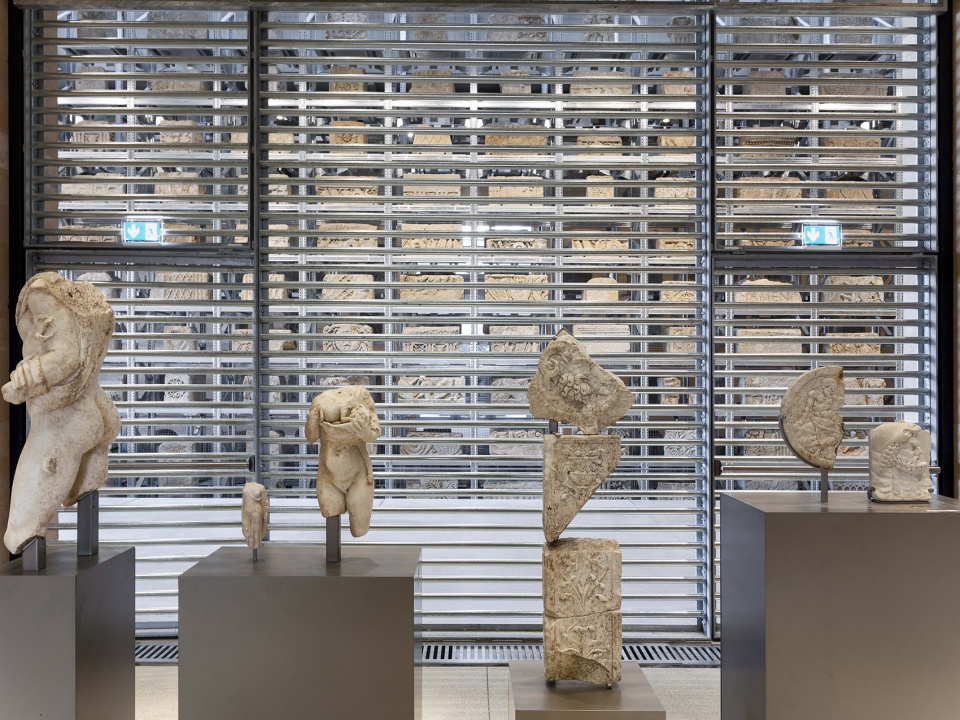
▼其他展览区域,exhibition area ©Nigel Young / Foster + Partners

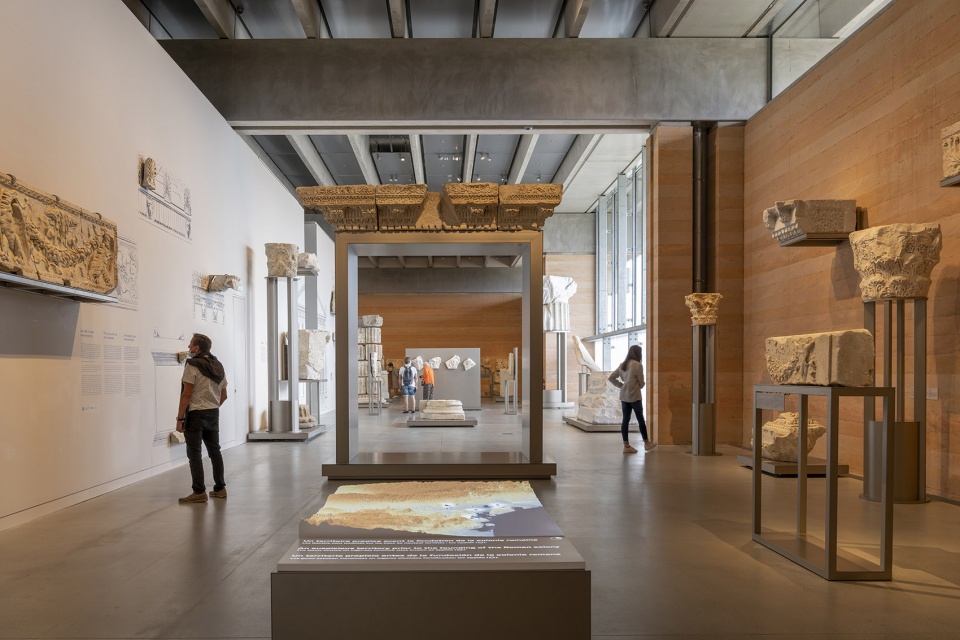
▼古罗马时期的文物藏品,antiquities from ancient Rome ©Nigel Young / Foster + Partners
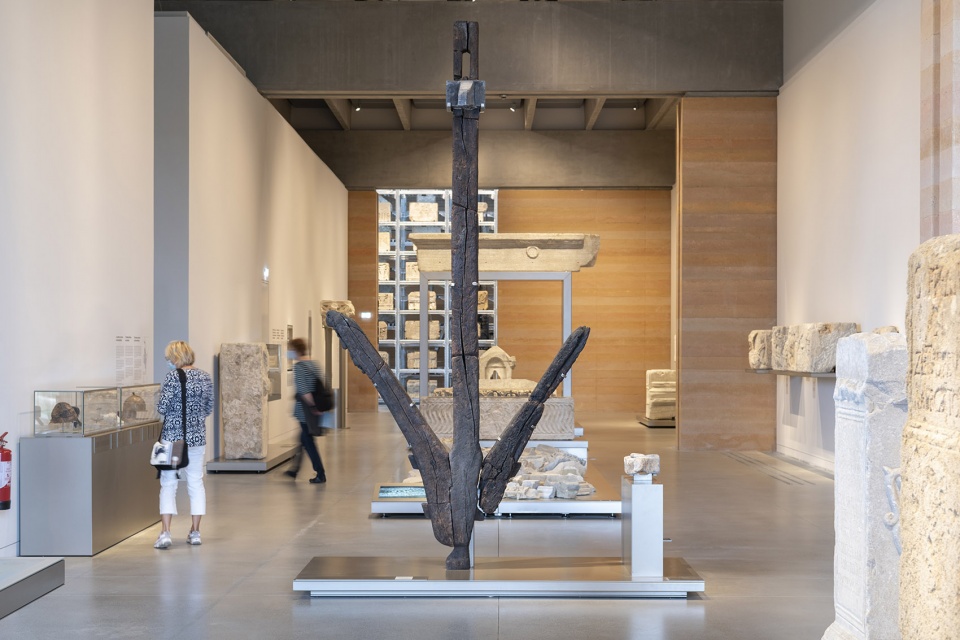
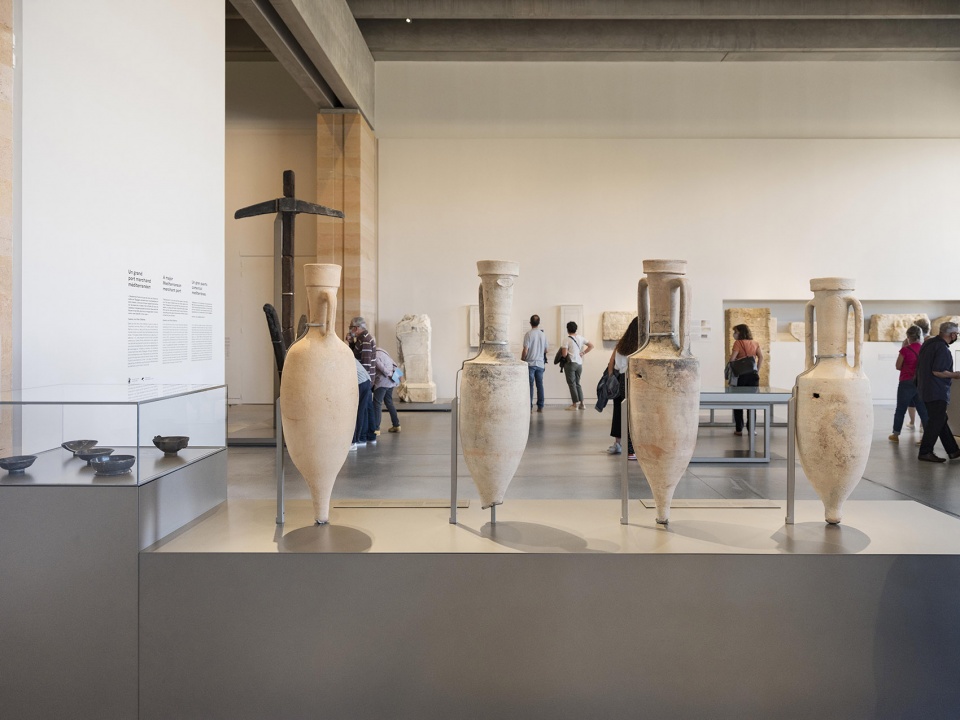
“古罗马时期,纳波恩曾是地中海沿岸一座令人引以为傲的港口城市,如今,它依旧具有重要的历史意义。因此,本项目的设计不仅涉及到了考古学,还将古代历史在当代背景下进行了灵活地转译。设计的核心理念旨在运用简单而灵活的建筑语言,激发起参观者的历史认同感,将博物馆与历史以及文化联系在一起,创造一座真正‘活着的’古代博物馆。”Foster + Partners事务所设计总监Spencer de Grey解释道。
Spencer de Grey, Head of Design, Foster + Partners, said: “Roman Narbonne was a proud port city along the Mediterranean, and remains a place of significant historical importance. The Narbo Via project, therefore, involved the deft navigation of archaeology and ancient history in a contemporary context. Our approach has been to create a simple yet flexible architectural language, one imbued with a sense of civic generosity and links to history and culture – essential for this museum of ‘living’ antiquity.”
▼夕阳中的博物馆,exterior view in the dusk ©Nigel Young / Foster + Partners
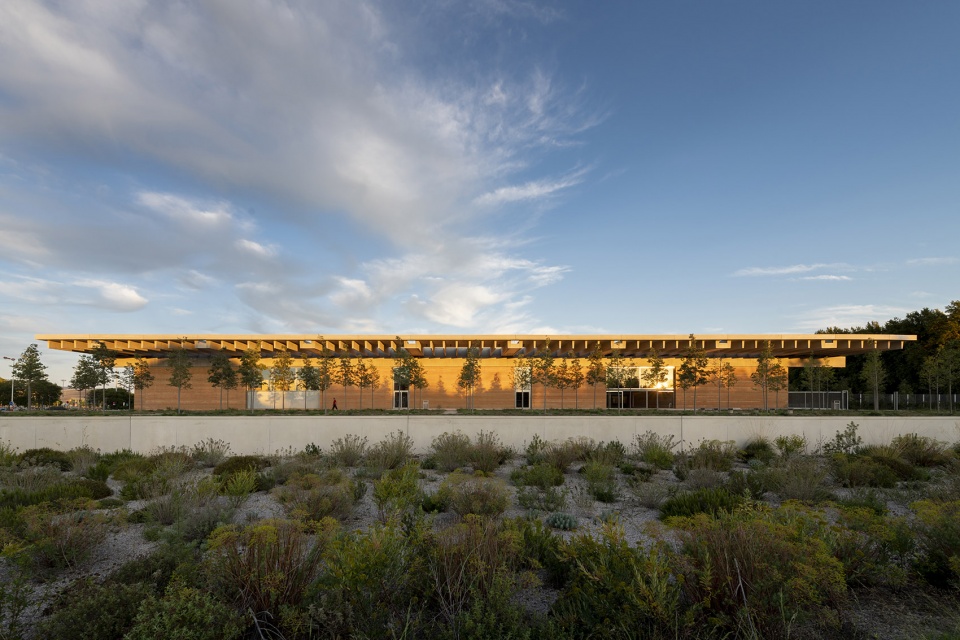
Foster + Partners的另一位合伙人Hugh Stewart补充说:“将这座城市中最具历史价值的古代藏品融入到当代背景下是一项令人兴奋的挑战。通过与Adrien Gardère事务所的合作,我们开发了垂直展示墙的概念,这面展示墙贯穿了整个建筑,使展品成为空间的主角与博物馆的核心。“
Hugh Stewart, Partner, Foster + Partners, added: “The idea of bringing the city’s remarkable ancient collection into an unashamedly contemporary context was a fascinating challenge. Working with Adrien Gardère, we developed the concept of a vertical display wall running the full width of the building, which puts the exhibits at the heart of the museum.”
▼总平面图,master plan ©Hazel Eynon Cole / Cecilia Shiels / Charlotte Bywaters / Foster + Partners
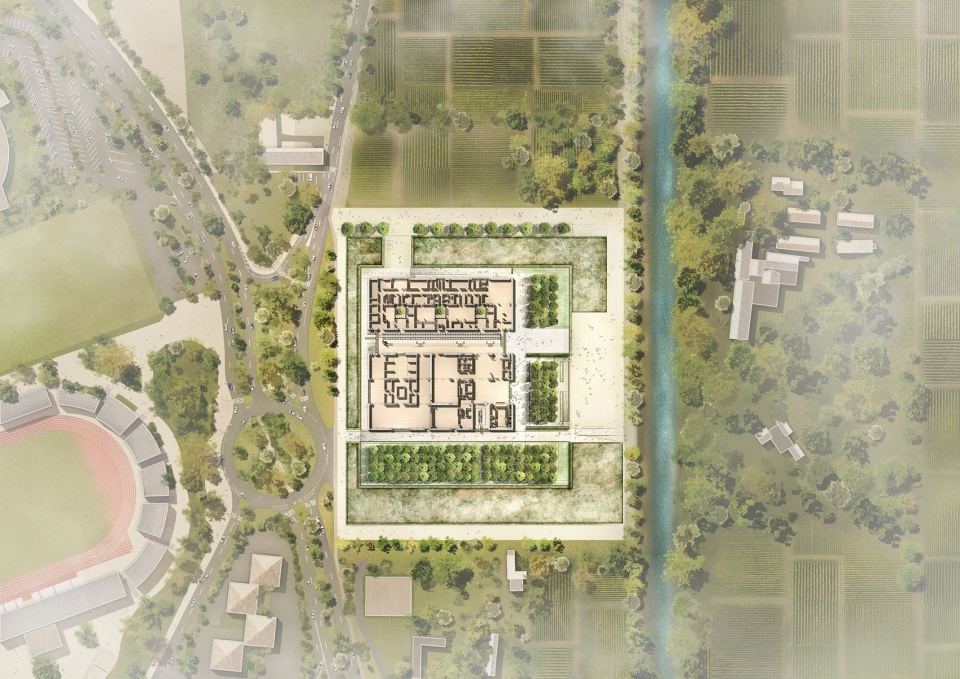
▼平面图,plans ©Foster + Partners
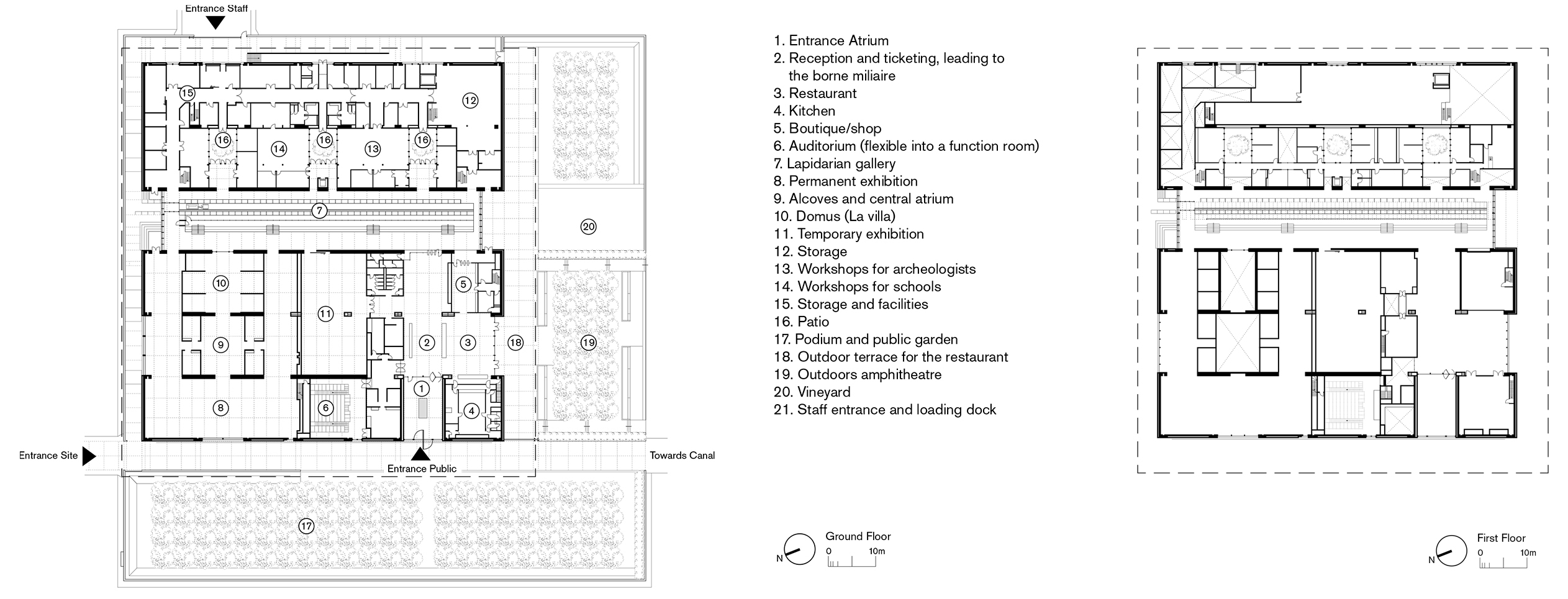
▼场地整体剖面图,section of the site ©Foster + Partners

▼博物馆立面图,elevation ©Hazel Eynon Cole / Cecilia Shiels / Charlotte Bywaters / Foster + Partners

▼博物馆剖面图,section ©Hazel Eynon Cole / Cecilia Shiels / Charlotte Bywaters / Foster + Partners











